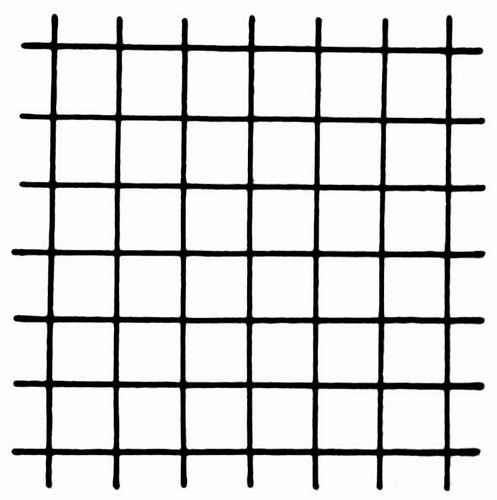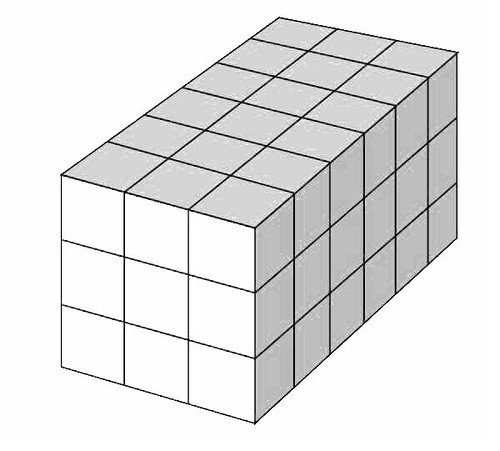I realize the title of this post is not very modest, but the post itself is, though I do touch on all of the subjects named. I don't presume to know everything there is to know about all of these subjects, but I want to introduce them and explain what they have to do with each other briefly. I will be writing more about these things, and related subjects, in later posts.
Here are a couple of pictures showing the Cartesian grid, so you'll have the grid in mind while reading what comes after.
The Cartesian Grid
"A co-ordinate system whose axes are straight lines intersecting at right angles"
(Ref: Ministry for the Environment, New Zealand)
3 Dimensional Cartesian Grid
Source: Wikipedia
Definition of a Cartesian grid: "A Cartesian grid is a special case [among grids] where the elements are unit squares or unit cubes, and the vertices are integer points." (Ref: Wikipedia Article on the Cartesian Grid)
Why is the Cartesian grid of any use to us? It doesn't look like much.
Awareness of the Cartesian grid is extremely useful to us, in our lives and in our art, because we live on Earth and so are very much under the influence of gravity (Gravity: The fundamental force of attraction that all objects with mass have for each other); it is gravity that makes those simple verticals and horizontals so necessary in order to understand and interpret our world (as viewed and experienced by inhabitants of our planet).
Gravity is a very strong force that pulls us, and everything we observe and live with, toward the center of the planet. In fact, it's what holds the planet itself together.
The artist who paints (or the sculptor who sculpts, etc.), if what they are depicting has to do with life as lived here on earth, has the effects of gravity in mind, whether he (or she) is consciously aware of it or not, as it is the dominant physical force in our lives. They might not plot their design on a Cartesian grid, yet they see and arrange and understand things as if they were doing so.
But the Cartesian grid looks so simple! (You say.) It's nothing more than vertical and horizontal lines! What do those lines have to do with life, and gravity, and art?
Let's start with the verticals.
The verticals in our lives
We live with gravity all our lives. We feel it as weight. Because we are constantly pulled from down below, we are very aware of what is "up" (pointing away from the center of the earth) and what is "down" (toward the center of the earth). Also, because we are aware (if only unconsciously) that everything on the surface of the earth is being pulled downward (or "has weight") we are inclined to infer that anything that's vertical (standing "up") has energy -- It is alive and alert and/or strong enough to resist the force of gravity.
The horizontals in our lives
Because we instinctively know how gravity works, things that are horizontal seem to us to be unthreatening, peaceful, meek, possibly even dead. They are not resisting gravity.
Photo Source: Wikipedia
When our energy is depleted, we lie down if possible, to sleep or just to rest. It requires no effort on our part to lie in a horizontal position.
The surfaces we walk and ride on are horizontal whenever it's possible to make them that way. Because of gravity, it's more difficult, and uses more energy (and is sometimes dangerous) to walk on or ride on an incline.
The places we live in (or prefer to live in) are usually as flat (i.e., horizontal) as possible because gravity makes it difficult for us to climb, or to descend with care (i.e., so that we will not fall). Even if the terrain is not flat, the floors of the buildings are; and, by the way, if we have flat floors the walls need to be vertical.
Building under construction
Photo Source: Wikipedia
If we lived in a place where gravity had no influence on us, there would be no up, nor would there be a down. There would be no definite verticals, nor horizontals. The verticals and horizontals of the Cartesian grid constitute the basic framework of our lives; everything is seen in relation to this framework.
Diagonals
If something is diagonal, that has meaning for us, too. Diagonals wouldn't have that meaning without the Cartesian grid showing us how they deviate from verticals and horizontals. A diagonal could be something rising, or something descending. (A vertical has already risen; a horizontal appears lifeless and not likely to make any moves.) So, diagonals mean "action" to us; something is happening (yes, diagonals can also imply depth).
Photo Source: Wikipedia
These diagonals do not look stable. It's alarming to see them like this. They're not vertical, nor are they horizontal, but they look like they're in the process of becoming horizontal. These diagonals make us nervous.
Relating vertical and horizontals (and diagonals) in life to those on the Cartesian grid
Standing people, trees, buildings, fenceposts, etc. look to us to be parallel to each other, as the vertical lines in the Cartesian grid are. Horizontals are connected at equal distances from each other to the verticals in the grid to make squares (in two dimensions), or make cubes (in three dimensions), making it simple to locate anything that is overlaid or represented by the grid.
The Cartesian grid helps us make many things that we use. Think of a map, or a pattern for a woodworking project or the grid you might use for transferring a picture from one surface to another. Graph paper is a Cartesian grid.
Furthermore, "The right angles of our living spaces, of chests and sheets, afford a visual order that helps make our lives simpler than they would be, say, in a primordial forest," says Rudolf Arnheim. "And, for the sake of order the Cartesian grid also remains present, actually or implicitly, in our works of art." (Arnheim: The Power of the Center, 1982 edition, paperback, page viii)
So we find the Cartesian grid very useful in measuring, planning, understanding, adapting to, representing and negotiating the spaces around us and in comprehending the meaning of what we see.
Two good links
1) I'm so glad I found this one. It's called The Coordinate Plane. It clearly and simply explains, and shows, how the two-dimensional Cartesian grid is used. Be sure to check what you want to see in the little boxes to the right of the diagram. Click "Grid" first, and you'll see it as it looks in the picture of the Cartesian Grid near the top of this post. Click each of the boxes to see what shows up. Also, you can move that little red dot around with your mouse pointer. When you are completely confused, click "Reset"
(under Quadrant 4) and it goes back to the way it was at the beginning. Be sure to read the definitions and suggestions below the grid. Also, there are other pages listed below that have to do with this subject. Just click on a link to get to what you want to see.
2) Wikipedia article on gravity
Quotations
"In daily perceptual experience, visual orientation in space relates to the Cartesian coordinates of the gravitational field." (Rudolf Arnheim in The Power of the Center, 1983, paperback, p. 197)
"The structure of visual space relies upon the framework provided by the vertical and horizontal. This framework is the visual 'tonic,' the zero base at which tension is at a minimum." (Rudolf Arnheim in New Essays on the Psychology of Art, 1986, paperback, p. 215)
"In the parochial view of its small inhabitants, the curvature of the earth straightens into a plane surface, and the converging radii become parallels." Rudolf Arnheim in The Power of the Center, 1983, paperback, p.vii)
"Parallelism and right-angled relation yield the most convenient framework available for spatial organization, and we cannot be grateful enough for living in a world that, for practical purposes, can be laid out along a grid of vertical and horizontals." Rudolf Arnheim in The Power of the Center, 1983, paperback, p.vii-viii)
"Were it not for gravity one man might hurl another by a puff of his breath into the depths of space, beyond recall for all eternity." -- Roger Joseph Boscovich, Philosophiae Naturalis Theoria, 1758.
May 25, 2009
Art, Gravity, Life, and the Cartesian Grid
Subscribe to:
Post Comments (Atom)

2 comments:
thanks==very helpful to me to understand this as i try to teach math as a teaching artist, not a math teacher (and someone who struggles with math in school).
I appreciate your comments very much. I'm always hoping I'll be able to help someone else understand what hasn't been easy for me to understand. - Jean
Post a Comment